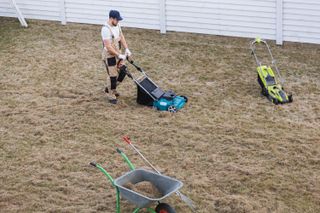Best time to scarify lawns? Our expert guide on why and when to do it
If your lawn is looking a bit scruffy, it may be time to scarify... Here's our guide on when and why to do it, plus how it makes your grass healthier

When is the best time to scarify lawns? Our lawns take a lot of abuse over the years from kids playing, the wear and tear generated by garden furniture, being baked by the sun, and deluged by rain.
Thatch, a layer of organic matter that accumulates on a lawn around the base of the grass plants, can cause a mossy and spongy lawn when it gets too thick because it prevents important nutrients such as water, fertiliser and oxygen from getting to the grass roots.
But you can rejuvenate yourgarden designby scarifying it, a process that improves its overall health by filtering out the moss that holds it back and nurturing the soil.
What is scarifying and why should I do it?
Scarifying, also known as de-thatching, is the process of removing thatch, moss, and other matter from the surface of the lawn that prevents healthy grass growth.
It is done using a scarifier, a tool that uses rolling blades to trim and remove the unhelpful organic matter holding your garden back. They come in simple push-and-pull manual versions, likethis handheld one, and powered models that rotate the blades for you, like thisfairly inexpensive electric scarifierormore pricey, but more heavy duty, Hyundai petrol scarifier and aerator, all from Amazon.
David Hedges Gower, chairman of theLawn Association, said: “Scarifying prunes native grasses, allowing them to thicken back up all on their own. It then reduces thatch and moss levels to be able to get the best results from any moss control product – moss killer has never and doesn’t exist.
“Controlling the thatch levels can then dry the lawn, leading to less chance for moss spores to germinate into plants. Prevention here is key.”
It is not the same as simply raking the lawn. Raking removes the moss on the lawn, while scarification removes surface thatch, which is the root cause of the moss.
Also, scarify is pronounced like ‘scar’ and not ‘scare’.

David is one of the UK's leading lawn experts, with over 30 years' experience in the industry. He is Chairman of theLawn Association, an educational platform for homeowners and professionals, and founded the world's first lawn care qualification.

When is the best time to scarify a lawn?
David adds: “Heavy scarifying should be done in March, April and September and October and lighter scarification can be done in Feb, May, and October too.
“These months are generally when the grass is growing very strongly and naturally making recovery much faster (and greener too).”
Scarifying leaves soil exposed in many places, so the lawn could be damaged if exposed to the rigours of winter or the scorching summer sun. If it doesn't grow back itself, it's worth checking out our guide onhow to sow grass seed.
Gardeners should also take a peek at the weather forecast. The process can leave the lawn a little vulnerable, so try to pick a time when the following few days look set to have moderate weather.

What should I bear in mind when scarifying?
It’s a good idea to mow your lawn a week before to remove excess grass and chop up any tangles as it will make the process easier. Take a look at our guide on 'when should I stop cutting my grass' for more general advice on mowing. You should also water the grass a couple of days before if it has been dry, or just wait a couple of days after it rains.
Do not scarify when it’s wet. You run the risk of pulling out clumps of grass along with the thatch. You may also want to scatter some grass seed after scarification.
You can manually remove weeds but don't use weed killer. Scarifying shortly after weed-killer application can disrupt the weed-killing process.
David concludes: “In lawns, it pays to use a machine with a fixed blade. This cuts through the shoots and stolons (a stem that grows along the ground surface) which will allow grasses to thicken right back up all on their own. The right tool for the right job.”
Get the Homebuilding & Renovating Newsletter
Bring your dream home to life with expert advice, how-to guides and design inspiration, direct to your inbox.
Sam is based in Coventry and has been a news reporter for nearly 20 years. His work has featured in the Mirror, The Sun, MailOnline, the Independent, and news outlets throughout the world. As a copywriter, he has written for clients as diverse as Saint-Gobain, Michelin, Halfords Autocentre, Great British Heating, and Irwin Industrial Tools. During the pandemic, he converted a van into a mini-camper and is currently planning to convert his shed into an office and Star Wars shrine.
